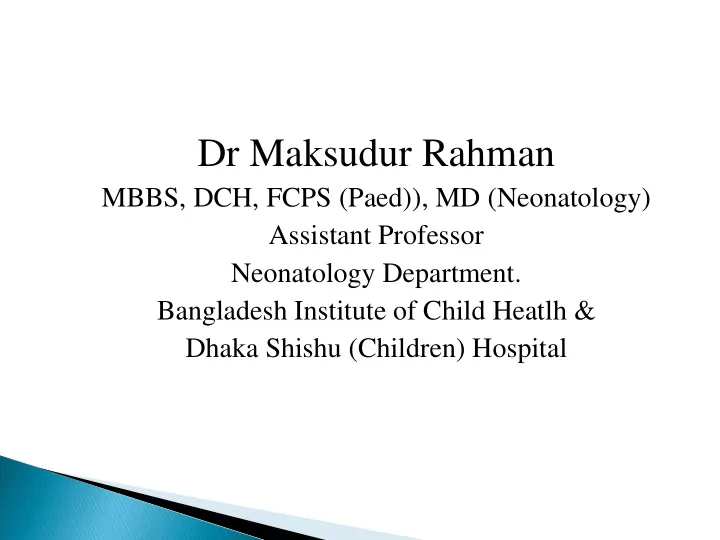

Dr Maksudur Rahman MBBS, DCH, FCPS (Paed)), MD (Neonatology) Assistant Professor Neonatology Department. Bangladesh Institute of Child Heatlh & Dhaka Shishu (Children) Hospital
Correlation of cardiac impairment with the severity of hypoxic ischemic encephalopathy and its immediate outcome.
Perinatal asphyxia is an insult to fetus or newborn due to a lack of oxygen (hypoxia) and /or a lack of perfusion(ischemia) to various organs which will manifest as difficulty in establishing spontaneous respiration evident by delayed cry after birth. .
Immediate morbidity and mortality of perinatal asphyxia is due to multiorgan dysfunction . The incidence of myocardial dysfunction in perinatal asphyxia ranges from 29 to 62%.
Respiratory distress, congestive cardiac failure, cardiogenic shock and systolic murmur(Tricuspid regurgitation and Mitral regurgitation ) are common feature related to cardiac impairment.
Cardiac troponin-I is more sensitive and specific than other cardiac enzymes. Echocardiographic changes in perinatal asphyxia are pulmonary hypertension, RV- hypokinesia , LV hypokinesia, Mitral regurgitation, RV/LV dilatation.
Assessment of the cardiac impairment in asphyxiated neonates may help to understand severity of perinatal asphyxia and predict its outcome.
To find out the cardiac function impairment in perinatal asphyxia in order to understand its relation with the outcome.
Specific Objectives A ) To asses cardiac function Clinically Serum Troponin- I 2-D Color Doppler Echocardiography.
B)To correlate cardiac impairment with Stages of HIE Mortality Hospital stay Of Asphyxiated neonates
• Study d dy design- Cross sectional study • Study p dy period- January 2012-december 2012 • Pl Plac ace o of study- Neonatal ward of Dhaka Shishu hospital • Study p dy popu pulation- Neonate admitted in Dhaka Shishu hospital • Samp ample S Siz ize -60 • Sampl pling M Methods ds-Purposive.
Inclusion criteria : Admitted neonates Age = 0-72 hours , Gestational age=35-42 weeks and along with following • H/o failure to breathe spontaneously immediately after birth and/or • H/o delayed /no cry after birth and/or H/o requirement of resuscitation and/or APGAR score ( at 5minute <5),when available.
Exclusion criteria - Major congenital anomaly . Clinical features consistent with congenital infection . Neonate with Sepsis ,meconium aspiration syndrome Congenital heart disease .
Hypoxic-ischemic encephalopathy was categorized clinically according to modified sarnat & sarnat stages (without EEG). Serum cardiac troponin-I, echocardiography Newborn was thoroughly examined with special attention to heart rate, blood pressure, capillary refill time at admission and during hospital stay and was monitored upto discharge or death.
All data were recorded systematically in preformed data collection form. Statistical analyses of the results was done by using a computer with SPSS-17 program. The results were presented in tables , diagram & graphs. Statistical tests X 2 ,Odds ratio ,Multiple logistic regression analysis for significance of difference were done.
Total Cases-60 Male= 36 (60)% Female= 24 (40%) Full term- 44 (74%) Preterm- 16 (26%)
Figure-1: Distribution of newborns according to severity of encephalopathy N=60 N=60 35(58.3%) 35 30 13(21.7%) 12(20%) 25 20 15 10 5 HI HIE-I I H HIE-II II HIE-III III 0 Thirteen (21.7%) newborns were in group –I, 35(58.3%) in Group-II and rest 12(20%) in group-III.
Clin Clinica ical l Number er(N (N) Percent ntage(% e(%) feat atures Convulsion 43 71.7% Respiratory 32 53.3% distress Comatose/ 11 18.3% stuporous Pallor 17 28.3%
Fig Figure-2: 2:Percentage of Raised S troponin- I in Perinatal Asphyxia 53.3% 42.7% 60 50 40 30 20 10 0 Troponin-I Troponin-I raised normal
Table-2: Echocardiography changes(n=60) Echocardiography number percentage Changes Pulmonary hypertension 16 26.6% Tricuspid 27 45% regurgitation(TR) Ventricular dysfunction 19 31.7% RV/RA dilatation 18 30% LA/LV dilatation 5 8.3%
cardiac impairment 28(47 32(53 absent %) %) cardiac impairment present
20(57%) 35 cardiac 30 impairment 25 present 1(8%) 20 11(91%) cardiac 15 15(43 12(92 impairment 10 %) absent % 5 1(9%) 0 1 2 3
HIE-I HIE- HIE- Chi P II III Value value 1 20 11 18.17 .0001 Cardiac P A impairment 13 15 1
31.4 0% 69.6 0% 100% cure 33.40 Gro roup-I 66.60 De… Gro roup-II % % Group-III Gro III Above figure shows that mortality of study newborns and were found 11 among 35 (31.4%) in group-II,8 among 12( 66.6%) in group- III and none in group-I .
Mortality 14(44% cure 18(56% death )
Cardiac impairment & Mortality Factors Death No Death OR P value ( X 2 test) (95% CI) Cardiac 18 14 impairment 30.60 .00001 No cardiac 1 27 (3.70- impairment 253.21) •OR=Odd Ratio>1=Significant risk factor. •Level of significant=p < 0.05.
Cardiac impairment & prolong hospital stay ≤10 days) OR (95% CI) Factors >10 days) P value ( X 2 test) Cardiac 15 17 impairment 7.35 .004 No cardiac (1.85-29.35 ) impairment 3 25 •OR=Odd Ratio>1=Significant risk factor. •Level of significant=p < 0.05.
Conclusion: Cardiac impairment directly correlates with the outcome of perinatal asphyxia and is a significant risk factor for morbidity and mortality. Simultaneously other organ impairments also contribute to severity of morbidity and mortality in perinatal asphyxia.
Small sample size Single centre study Financial constraint.
THANK YOU
̈ Table-3: Percentage of organ involvement in Perinatal asphyxia Organs Number Percentage CNS 60 100% Respiratory 35 58.3% cardiac 32 53.3% Hepatic 12 20% Renal 20 33.3%
Tabl ble-8 : Multiple logistic regression of organ impairment for mortality Organ Sig. Exp(B) Cardiac impairment .184 10.404 Respiratory impairment .734 1.846 Renal impairment .459 1.740 Hepatic impairment .025 6.601 *Exp(B) represents the ratio change in the odds of the event of interest for one unite change in the predictor Sig.=level of significant <.05
Troponin I I : Raised ≥0.183µg/l Card rdiac imp c impair irment: 1)Clinical feature of cardiac involvement (Tachycardia/bradycardia and CRT>3Sec/ hypotension/systolic murmur ) with or without 2) S.Troponin- I >0.183µg/l. with or without 3) Echocardiographic finding (pulmonary hypertension , RV-hypokinesia LV hypokinesia, Tricuspid regurgitation,Mitral regurgitation and RV/LV dilatation). 10,12,21
Recommend
More recommend